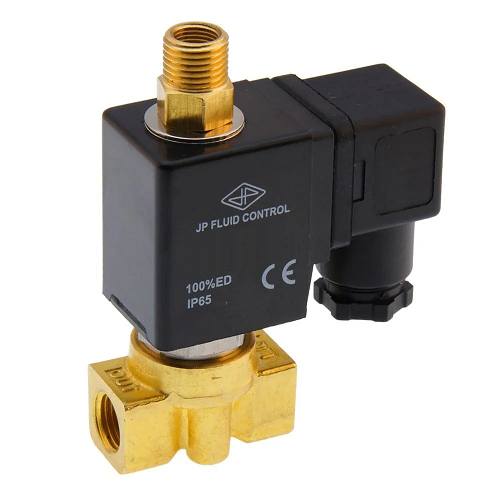
our category
SOLENOID VALVE
Solenoid Valve: An Overview
A solenoid valve is an electromechanical device that controls the flow of fluids or gases in a system. It operates by using an electrical current to generate a magnetic field that moves a plunger or armature, which opens or closes the valve. Solenoid valves are commonly used for automated control in industries like manufacturing, HVAC systems, irrigation, and medical equipment, offering reliable, fast, and precise control over the flow of liquids, gases, or steam.
Enquire Now
Key Features of Solenoid Valves:
- Electromechanical Operation: Solenoid valves are activated by an electrical signal that energizes a solenoid coil. This coil creates a magnetic field that actuates a plunger to open or close the valve.
- Variety of Types: Solenoid valves come in different configurations, including two-way, three-way, and four-way valves, each with its own function based on the application.
- Two-Way Solenoid Valve: Controls the flow between two points, typically used for simple on/off control.
- Three-Way Solenoid Valve: Redirects flow between two output points, often used in control systems requiring a change in flow direction.
- Four-Way Solenoid Valve: Used in more complex systems like pneumatic control to manage multiple flow paths.
- Quick Response: Solenoid valves can open and close rapidly, making them suitable for systems that require fast operation and high-frequency switching.
- Compact Design: These valves are relatively compact and easy to integrate into various systems without requiring large amounts of space.
How Solenoid Valves Work:
A solenoid valve consists of a coil, a plunger, and a valve body. When an electric current is passed through the solenoid coil, it generates a magnetic field that pulls or pushes the plunger inside the valve. The movement of the plunger either opens or closes the valve, allowing or stopping the flow of fluid or gas. Once the current is removed, the magnetic field dissipates, and a spring or other mechanism returns the plunger to its original position, closing or opening the valve as needed.
Types of Solenoid Valves:
- Normally Open (NO) Solenoid Valve: The valve remains open when the solenoid is not energized and closes when electrical current is applied.
- Normally Closed (NC) Solenoid Valve: The valve remains closed when the solenoid is not energized and opens when electrical current is applied.
- Direct Acting Solenoid Valve: The solenoid directly actuates the valve, typically used in small, low-pressure systems.
- Indirect Acting Solenoid Valve: The solenoid controls a diaphragm or piston that, in turn, controls the flow of fluid, used in larger, high-pressure systems.
- Pilot Operated Solenoid Valve: These use system pressure to assist the solenoid’s operation and are typically used in high-flow or high-pressure systems.
Common Applications:
- Automated Control Systems: Solenoid valves are frequently used in automated systems for controlling the flow of air, water, or steam, such as in pneumatic systems or industrial automation.
- HVAC Systems: In heating, ventilation, and air conditioning systems, solenoid valves control the flow of refrigerants or water, enabling temperature control and efficient operation.
- Irrigation Systems: Solenoid valves are used in irrigation systems to automate the opening and closing of water valves for various sectors, including agriculture and landscaping.
- Medical Equipment: In medical devices, such as oxygen concentrators, solenoid valves help regulate the flow of gases or fluids.
- Fluid Control in Manufacturing: In manufacturing processes that require precise fluid flow control, solenoid valves ensure the accurate operation of machines and equipment.
- Water Treatment: Solenoid valves are used in water treatment plants to control the flow of chemicals, water, and wastewater in various stages of the treatment process.
Advantages:
- Automation: Solenoid valves enable fully automated operation of systems, reducing the need for manual intervention.
- Fast Response: These valves can open or close quickly, making them suitable for systems requiring rapid flow control.
- Compact and Efficient: Solenoid valves are space-efficient and energy-efficient, offering precise control without taking up much space.
- Durability: With their simple, robust design, solenoid valves are durable and reliable in a wide range of operating conditions.
- Cost-Effective: Compared to other types of valves, solenoid valves are relatively inexpensive and easy to maintain, making them a cost-effective solution for various applications.
Disadvantages:
- Power Dependency: Solenoid valves rely on electrical power to operate. If the power supply is interrupted, the valve may not function, which can be a concern in critical applications.
- Temperature and Pressure Limits: Solenoid valves may have limitations in terms of the maximum operating temperature and pressure, which can restrict their use in some extreme environments.
- Wear and Tear: Over time, the solenoid coil or the plunger can wear out, especially if the valve is exposed to frequent cycling, requiring maintenance or replacement.
- Noise: Solenoid valves can generate noise when the solenoid coil is energized or de-energized, especially in high-frequency switching applications.
Conclusion:
Solenoid valves are essential components in modern automated systems that require precise, fast, and reliable control of fluid or gas flow. With their ability to provide quick actuation, versatility in applications, and compact design, solenoid valves are widely used in industries such as manufacturing, HVAC, medical equipment, and irrigation. While they come with some limitations, such as power dependency and wear over time, their benefits in terms of automation, cost-effectiveness, and ease of use make them a preferred choice for fluid control applications.
